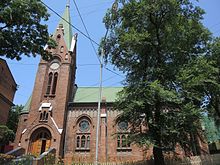Paul's Church (Vladivostok)
The Pauluskirche in Vladivostok is the most easterly Lutheran place of worship in the Russian Federation and the oldest church building in the port city of Vladivostok on the Sea of Japan .
Church building
1907 to 1935
The German architect Georg Junghändel , who was also involved in the construction of the Berlin Cathedral , built the Vladivostok Pauluskirche in the center of the city at today's ul.Puschkinskaja 14. It was a church of a community, to which important, mostly German-speaking people belonged, among others Governors, admirals, merchants, scientists and artists. In 1914 the Paulus parish had 4,000 parishioners. An important sponsor of the church named after the Apostle Paul and at the same time chairman of the church council for many years was Adolph Dattan , the head of the German trading house " Kunst und Albers ".
In addition to the Orthodox congregation, the Paulus congregation was the oldest congregation in the city of Vladivostok, and Lutherans played a key role in its founding in 1860. Today the oldest church building in the city next to the train station is the most valuable architectural monument in Vladivostok and is a listed building .
In 1935, the "end" for the Paulus Church and its congregation struck: Just as in other Russian cities, the Stalinist ideology of this time destroyed churches and congregations. In Vladivostok the pastor of the Paulus congregation, Woldemar Reichwald , was kidnapped and died a martyr's death .
1935 to 1992
After 1935 the church was converted into a sailors club, then a cinema. Eventually it became the Military Museum of the Soviet Pacific Fleet . In 1992 cannons and small tanks stood in front of the church; in the church, between machine guns and pictures of the fleet, a bust of Lenin stood on the site of the altar.
Since 1992
The political change caused by perestroika and glasnost made a new life possible for the Lutheran community in Vladivostok. She was re-registered in 1992 and has fought for the return of her church ever since. This took place on September 16, 1997 with the decisive participation and presence of the then German ambassador Ernst-Jörg von Studnitz . The Pauluskirche was raised to the rank of a German cultural monument abroad , comparable to the Königsberg Cathedral in Kaliningrad .
The building was in an extremely neglected, almost dilapidated condition. The roof was leaking, there were buckets in the building to catch rainwater. A large crack ran through the wall to the right of the apse .
After the church was returned, the congregation began extensive renovation work , which was possible thanks to the support of church and secular organizations from all over the world, especially from Germany. Numerous specialists took part in the restoration, including many voluntary helpers from home and abroad. A craftsman from Dithmarschen in Germany was significantly involved: Rainer Matthäus Muus , who worked here between 2002 and 2008.
First of all, all the bricks in the interior of the church had to be ground down and all the arches rebuilt. The two side walls inside were completed, plastering followed later. Cracks in the walls were removed and secured with steel clamps. The wood in the ceiling beams was given a new coat of paint in the original color. Finally, it was necessary to build a flight of stairs at the main entrance to the church and to build a new door.
A brick floor, which was sealed with oil, now characterizes the picture inside the church, in the tower of which the bell room was prepared and three bells made by the Bachert bell foundry in Karlsruhe , Germany were hung and handed over to their destination at Easter 2009.
In 2006 the church received its first organ as a gift from Australia and in 2008 a second from Germany. In 2010 the installation of new pictorial colored glazing began; The Holy Trinity is depicted in the apse window . The Hamburg painter Carolin Beyer created two depictions of Jesus and Paul , which hang to the left and right of the apse.
Parish
The parish of St. Paul's Church in Vladivostok, which celebrated the 100th anniversary of its church in 2007, belongs to the Evangelical Lutheran Church in the Urals, Siberia and the Far East (ELKUSFO) with the bishopric in Omsk . ELKUSFO is part of the Evangelical Lutheran Church in Russia, Ukraine, Kazakhstan and Central Asia (ELKRAS) with the official seat of the Archbishop in Saint Petersburg . The retired pastor Manfred Brockmann , who is also provost of the Far East provost, has been working here since 1992 .
gallery
literature
- Manfred Brockmann: ... a church far in the east ... A short history of the Pauluskirche in Vladivostok. In: Lutheran Service. Journal of the Martin-Luther-Bund in cooperation with the DNK / LWB, 46th year, 2010, issue 4.
Web links
- luthvostok.com - Official Church website (Russian, German, English)
- Website of the Lutheran Congregations in the Russian Far East (Vladivostok)
Individual evidence
- ↑ Sven Töniges: Where the Trans-Siberian Railway ends. A tour of the port of Vladivostok. Deutschlandfunk, January 4, 2009.
- ↑ Manfred Brockmann, pastor at the Pauluskirche in Vladivostok: The Pauluskirche in Vladivostok has two new pictures: Christ the King and the Apostle Paul . June 2016 on the website of St. Paul's Church in Vladivostok.
Coordinates: 43 ° 7 ′ 0 ″ N , 131 ° 54 ′ 0 ″ E





